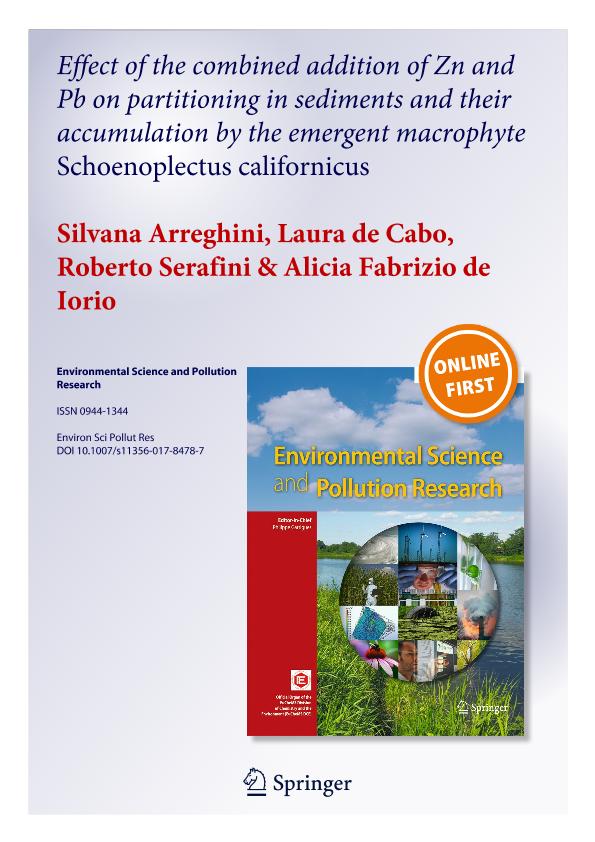Mostrar el registro sencillo del ítem
dc.contributor.author
Arreghini, Silvana

dc.contributor.author
de Cabo, Laura Isabel

dc.contributor.author
Serafini, Roberto José María

dc.contributor.author
Fabrizio de Iorio, Alicia Rosa

dc.date.available
2018-12-07T20:20:10Z
dc.date.issued
2017-03
dc.identifier.citation
Arreghini, Silvana; de Cabo, Laura Isabel; Serafini, Roberto José María; Fabrizio de Iorio, Alicia Rosa; Effect of the combined addition of Zn and Pb on partitioning in sediments and their accumulation by the emergent macrophyte Schoenoplectus californicus; Springer Heidelberg; Environmental Science and Pollution Research; 24; 9; 3-2017; 8098-8107
dc.identifier.issn
0944-1344
dc.identifier.uri
http://hdl.handle.net/11336/66095
dc.description.abstract
Wetlands usually provide a natural mechanism that diminishes the transport of toxic compounds to other compartments of the ecosystem by immobilization and accumulation in belowground tissues and/or soil. This study was conducted to assess the ability of Schoenoplectus californicus growing in natural marsh sediments, with zinc and lead addition, to tolerate and accumulate these metals, taking account of the metal distribution in the sediment fractions. The Zn and Pb were mainly found in available (exchangeable) and potentially available (bound to organic matter) forms, respectively. The absorption of Zn and Pb by plants increased in sediments with added metals. Both metals were largely retained in roots (translocation factor < 1). Lead rhizome concentrations only increased significantly in treatments with high doses of metal independently of added Zn. The addition of Zn increased its concentration in roots and shoots significantly, while its concentration in rhizomes only increased when both metals were added together. Zinc concentration in shoots did not reach the toxic level for plants. Zinc and Pb concentrations in roots were high, but they were not sufficient to reduce biomass growth.
dc.format
application/pdf
dc.language.iso
eng
dc.publisher
Springer Heidelberg

dc.rights
info:eu-repo/semantics/openAccess
dc.rights.uri
https://creativecommons.org/licenses/by-nc-sa/2.5/ar/
dc.subject
Bioavailability
dc.subject
Metal Uptake
dc.subject
Schoenoplectus Californicus
dc.subject
Sediments
dc.subject
Translocation
dc.subject
Wetlands
dc.subject.classification
Meteorología y Ciencias Atmosféricas

dc.subject.classification
Ciencias de la Tierra y relacionadas con el Medio Ambiente

dc.subject.classification
CIENCIAS NATURALES Y EXACTAS

dc.title
Effect of the combined addition of Zn and Pb on partitioning in sediments and their accumulation by the emergent macrophyte Schoenoplectus californicus
dc.type
info:eu-repo/semantics/article
dc.type
info:ar-repo/semantics/artículo
dc.type
info:eu-repo/semantics/publishedVersion
dc.date.updated
2018-10-23T19:54:09Z
dc.journal.volume
24
dc.journal.number
9
dc.journal.pagination
8098-8107
dc.journal.pais
Alemania

dc.journal.ciudad
Heidelberg
dc.description.fil
Fil: Arreghini, Silvana. Consejo Nacional de Investigaciones Científicas y Técnicas; Argentina. Universidad de Buenos Aires. Facultad de Agronomía. Departamento de Recursos Naturales y Ambiente. Cátedra de Química Analítica; Argentina
dc.description.fil
Fil: de Cabo, Laura Isabel. Consejo Nacional de Investigaciones Científicas y Técnicas; Argentina. Consejo Nacional de Investigaciones Científicas y Técnicas. Oficina de Coordinación Administrativa Parque Centenario. Museo Argentino de Ciencias Naturales “Bernardino Rivadavia”; Argentina
dc.description.fil
Fil: Serafini, Roberto José María. Consejo Nacional de Investigaciones Científicas y Técnicas; Argentina. Universidad de Buenos Aires. Facultad de Agronomía. Departamento de Recursos Naturales y Ambiente. Cátedra de Química Analítica; Argentina
dc.description.fil
Fil: Fabrizio de Iorio, Alicia Rosa. Universidad de Buenos Aires. Facultad de Agronomía. Departamento de Recursos Naturales y Ambiente. Cátedra de Química Analítica; Argentina
dc.journal.title
Environmental Science and Pollution Research

dc.relation.alternativeid
info:eu-repo/semantics/altIdentifier/doi/https://dx.doi.org/10.1007/s11356-017-8478-7
dc.relation.alternativeid
info:eu-repo/semantics/altIdentifier/url/https://link.springer.com/article/10.1007/s11356-017-8478-7
Archivos asociados
